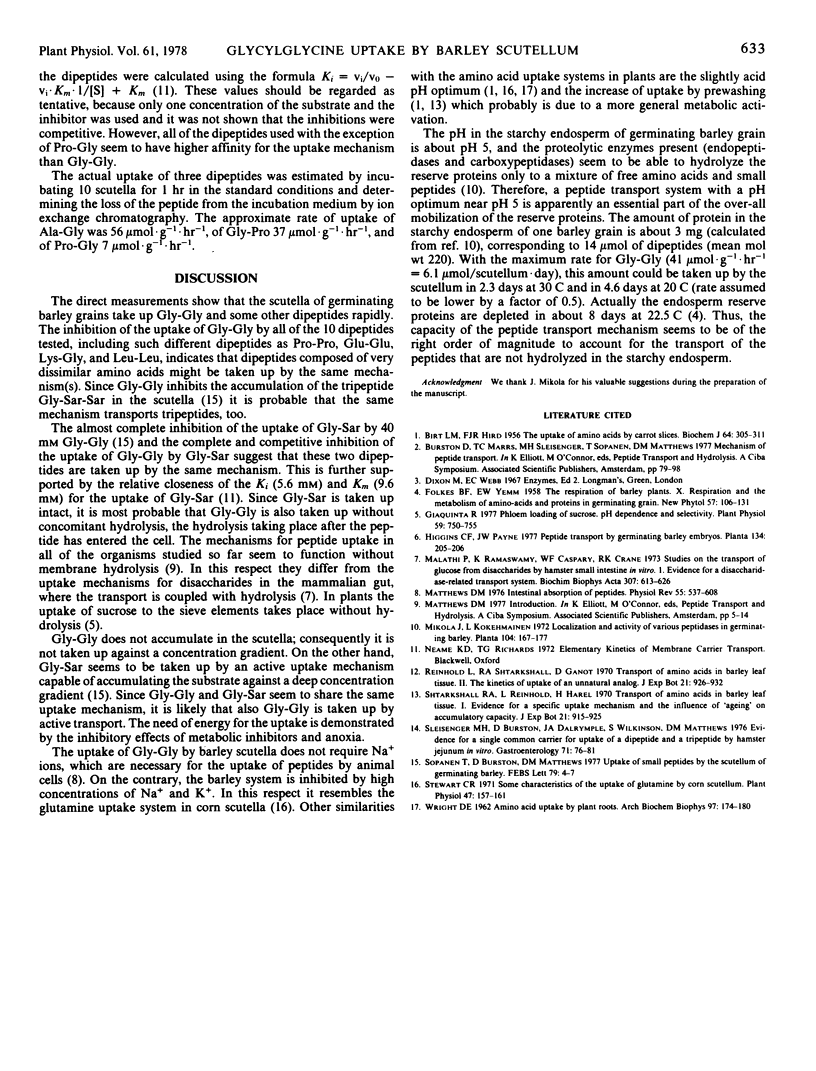Abstract
The scutella separated from germinating barley grains (Hordeum vulgare L. cv. Himalaya) took up the dipeptide [14C]glycylglycine (Gly-Gly) rapidly from incubation media. The pH optimum of the process was about 4.5, and the rate of uptake conformed to Michaelis-Menten kinetics with an apparent Km of 2.3 mm and Vmax of 41 μmole gram−1 hour−1. The uptake was strongly inhibited by dinitrophenol and cyanide and by lack of O2.
After incubation of the scutella with Gly-Gly, no intact Gly-Gly was detectable in the scutella but the level of free glycine increased. The poorly hydrolyzed “model” dipeptide glycylsarcosine, which is actively taken up and accumulated by the scutella, was a competitive inhibitor of the uptake of Gly-Gly and completely inhibited the uptake at infinitely high inhibitor concentration. This suggests that Gly-Gly is taken up by the same mechanism as glycylsarcosine as an intact dipeptide (without hydrolysis in the membrane) and is hydrolyzed to free glycine by the abundant peptidases of the scutella.
The uptake of Gly-Gly was not affected by glycine or leucine, but was strongly inhibited by all of the 10 dipeptides tested for inhibition. The three dipeptides tested for uptake, Ala-Gly, Pro-Gly, and Gly-Pro, were all taken up by the scutella. Thus, the uptake mechanism for the dipeptides seems to be rather nonspecific with respect to the side chains of the amino acids. The high rates of the uptake suggest that this process has an essential role in the mobilization of reserve proteins in the germinating grain.
Full text
PDF



Selected References
These references are in PubMed. This may not be the complete list of references from this article.
- BIRT L. M., HIRD F. J. The uptake of amino acids by carrot slices. Biochem J. 1956 Oct;64(2):305–311. doi: 10.1042/bj0640305. [DOI] [PMC free article] [PubMed] [Google Scholar]
- Giaquinta R. Phloem Loading of Sucrose: pH Dependence and Selectivity. Plant Physiol. 1977 Apr;59(4):750–755. doi: 10.1104/pp.59.4.750. [DOI] [PMC free article] [PubMed] [Google Scholar]
- Malathi P., Ramaswamy K., Caspary W. F., Crane R. K. Studies on the transport of glucose from disaccharides by hamster small intestine in vitro. I. Evidence for a disaccharidase-related transport system. Biochim Biophys Acta. 1973 May 25;307(3):613–626. doi: 10.1016/0005-2736(73)90306-4. [DOI] [PubMed] [Google Scholar]
- Matthews D. M. Intestinal absorption of peptides. Physiol Rev. 1975 Oct;55(4):537–608. doi: 10.1152/physrev.1975.55.4.537. [DOI] [PubMed] [Google Scholar]
- Matthews D. M. Introduction. Membrane transport of peptides. Ciba Found Symp. 1977;(50):5–14. [PubMed] [Google Scholar]
- Sleisenger M. H., Burston D., Dalrymple J. A., Wilkinson S., Mathews D. M. Evidence for a single common carrier for uptake of a dipeptide and a tripeptide by hamster jejunum in vitro. Gastroenterology. 1976 Jul;71(1):76–81. [PubMed] [Google Scholar]
- Sopanen T., Burston D., Matthews D. M. Uptake of small peptides by the scutellum of germinating barley. FEBS Lett. 1977 Jul 1;79(1):4–7. doi: 10.1016/0014-5793(77)80337-2. [DOI] [PubMed] [Google Scholar]
- Stewart C. R. Some characteristics of the uptake of glutamine by corn scutellum. Plant Physiol. 1971 Jan;47(1):157–161. doi: 10.1104/pp.47.1.157. [DOI] [PMC free article] [PubMed] [Google Scholar]
- WRIGHT D. E. Amino acid uptake by plant roots. Arch Biochem Biophys. 1962 Apr;97:174–180. doi: 10.1016/0003-9861(62)90061-9. [DOI] [PubMed] [Google Scholar]


